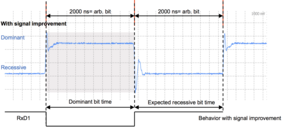SIC transceivers for CAN FD

The achievable bit-rate depends on the network topology and the selected physical layer components such as cable and connectors. Using pure bus-line topologies enables bit-rates of 2 Mbit/s respectively 5 Mbit/s. In order to enable the use of not ideal topologies, the data-phase bit-rate needs to be lowered. Another option is to use so-called SIC (signal improvement capability) transceivers, which suppress the ringing causes by the not optimized network topology. These SIC transceivers are specified in CiA 601-4. There are two implementations available: one suppresses the ringing when transmitting; the other filters the ringing when receiving.
Recently, the nonprofit CAN in Automation (CiA) association has released the CiA 601-4 version 2.0. “It is an important step for the automotive industry to use CAN FD also in hybrid topology networks at high bit-rates,” said Holger Zeltwanger, CiA Managing Director. “SIC transceivers from several manufacturers will be available, soon.” The released document specifies also the EMC (electromagnetic compatibility) testing.